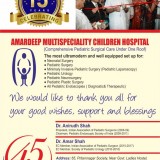INFORMATION AVAILABLE IN ENGLISH, GUJARATI AND HINDI
The condition of having an additional little finger on one or both hands is very common, especially in certain ethnic groups.
Usually it is inherited, with a 50 per cent or one in two chance of it happening if the parents have it.
At other times, it happens spontaneously, without anyone else in the family being previously affected.
When your child has an additional little finger, there is a 50 per cent or one in two chance of his or her children also being born with one.
Can it cause any problems?
Sometimes the extra finger is well formed, but more commonly it has a narrow base or stalk and is dangling from the edge of the normal hand or leg. The place where the extra finger joins the hand might be bony or it could just be a soft stalk.
If the extra finger has a narrow stalk, it can twist, cutting off the blood supply so it turns blue or black. The extra finger has a nerve supply so it will be painful if this happens.
How can the extra little finger be corrected?
The extra little finger(s) can be removed in a short operation.
Are there any risks?
It is a relatively safe procedure with no major complications.
There will be a scar where the extra finger was removed, but this is quite small. It usually fades gradually with time, so that it is less noticeable but it will always be there.
What would happen if my child did not have the operation?
The extra little finger should not cause any problems if it is taped securely to the next finger. However, most parents ask for the extra finger to be removed, as it can lead to unwanted attention for their child as they grow older.
What does the operation involve?
Once the anaesthetic has started to work, the surgeon will remove the extra finger, stopping its blood supply. He will stitch the operation site closed and cover it with a dressing. The operation lasts around 15- 20 minutes to remove one extra finger and slightly longer if an extra finger needs to be removed from both hands.
When you get home
Keep the operation site dry and covered with the light dressing for one week.
All the stitches used are dissolvable and will begin to rub off in around two weeks. The light dressing can be gently peeled off after a week or so.
After two weeks, if the operation site has healed, you can massage the scar with coconut oil/ antiseptic ointment twice a day until the scar has faded.
GUJARATI
બાળકની આંગળીઓની ખોડ
બાળકનાં હાથ અને પગની આંગળીઓમાં ઘણી ખોડ જાવા મળે છે. જા એક-બે આંગળીઓની ખોડ હોય તો સર્જરીનાં રીઝલ્ટ સારા આવે છે પણ ઘણી વખત હાથ કે પગની આંગળીઓની સાથે તેમાં રહેલાં હાડકાં પણ ખોડ વાળા હોય તો બાળક આ ખોડ સાથે સારું કામ કરી શકે તેવી સર્જરી કરવામાં આવે છે. આમાં સંપૂર્ણ નોર્મલ દેખાય તેવાં હાથ નથી કરી શકાતા.
આ ખોડ ૧ ૧/૨ વર્ષની આસપાસ આૅપરેશન દ્વારા છૂટી કરી શકાય છે.
હાથ કે પગમાં પાંચ આંગળીઓ કરતાં વધુ હોય તો તેને પોલીડેક્ટલી કહેવામાં આવે છે. સામાન્ય રીતે એક્સ્ટ્રા આંગળીઓ કાઢવાની સર્જરી ૧ વર્ષ પછી કરાવવી, પણ જા એક્સ્ટ્રા આંગળી ફક્ત ચામડીથી જાડાયેલી હોય અને તેમાં વળ ખાઈ ગેંગરીન થાય છે તો તે માટે તાત્કાલિક આૅપરેશન કરાવવું પડે છે. •
HINDI
बच्चों की अंगुलियों की विसंगति
सींडेक्टली अर्थात ‘जुड़ी हुई अंगुलियाँ’ वह स्थिति है जब बच्चे के विकास के दौरान दो या दो से अधिक अंगुलिया पूरी तरह से अलग नहीं हो पाती है। कभी-कभी कुछ बच्चे बिना किसी उपचार के भी कार्य कर सकते है। पैर के अंगूठे के सिंडेक्टिली का उपचार आमतौर पर कार्यात्मक कारणों से अधिक कॉस्मेटिक कारणों से किया जाता है (ताकि बच्चा चप्पल/स्लीपर पहन सके)। सर्जरी के लिए कभी-कभी त्वचा निरोपन की आवश्यकता पड़ती है।
पॉलीडेक्टीलीमें बच्चे को अतिरिक्त अंगुलियाँ अथवा अंगूठे होते हैं। यह एक या दोनों हाथ अथवा पांव में हो सकती है। अधिकतर मामलों में ये अतिरिक्त अंगुलियाँ छोटे से डंठल पर नर्म मांस-तंतु के समान होती हैं। कभी-कभी इनमें बिना किसी जोड़ के हड्डी होती है; और यह शायद ही कभी पूर्णतया कार्यशील अंगुली के रूप में होती है। सींडेक्टली के लिए सर्जरी १भ वर्ष की आयु होने पर की जाती है। अतिरिक्त अंगुली केवल त्वचा से जुड़ी हो और इसमें मरोड़ उत्पन्न हो जाए तो यह एक आपात स्थिति पैदा कर सकती है। •




